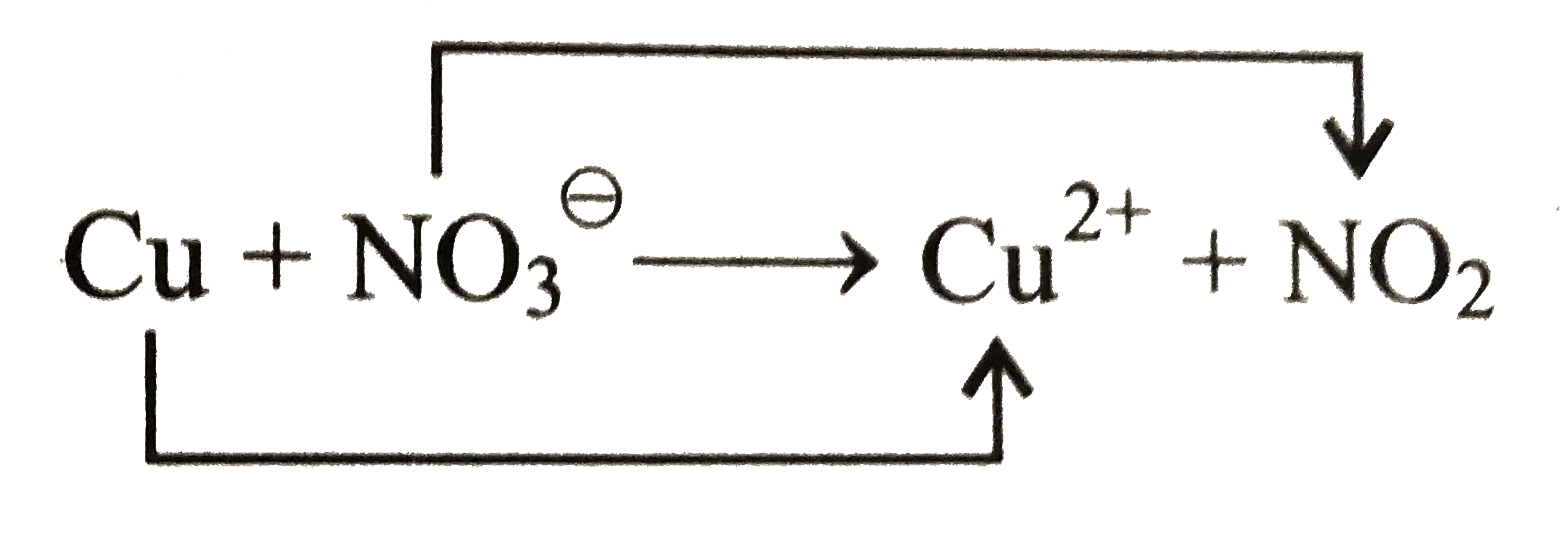Copper reacts with conc. Nitric acid. Give balanced reaction.
To balance the chemical equation for the reaction of copper with concentrated nitric acid, we will follow these steps:
Step 1: Write the unbalanced equation
The reactants are copper (Cu) and concentrated nitric acid (HNO₃). The products of this reaction are copper(II) nitrate (Cu(NO₃)₂), nitrogen dioxide (NO₂), and water (H₂O).
The unbalanced equation is:
Cu (s)+HNO3(aq)→Cu(NO3)2(aq)+NO2(g)+H2O (l)
Step 2: Identify the number of atoms of each element
- Reactants:
- Cu: 1
- H: 1
- N: 1
- O: 3
- Products:
- Cu: 1 (in Cu(NO₃)₂)
- H: 2 (in H₂O)
- N: 2 (in Cu(NO₃)₂) + 1 (in NO₂) = 3
- O: 6 (in Cu(NO₃)₂) + 2 (in NO₂) + 1 (in H₂O) = 9
Step 3: Balance the nitrogen atoms
Since there are 3 nitrogen atoms in the products and only 1 in the reactants, we need to balance the nitrogen by adjusting the coefficient of HNO₃. Placing a coefficient of 4 in front of HNO₃ gives us:
Cu (s)+4HNO3(aq)→Cu(NO3)2(aq)+2NO2(g)+H2O (l)
Step 4: Update the count of atoms
Now let's recount the atoms:
- Reactants:
- Cu: 1
- H: 4
- N: 4
- O: 12
- Products:
- Cu: 1
- H: 2
- N: 2 (in Cu(NO₃)₂) + 2 (in 2 NO₂) = 4
- O: 6 (in Cu(NO₃)₂) + 4 (in 2 NO₂) + 1 (in H₂O) = 11
Step 5: Balance the hydrogen atoms
We have 4 hydrogen atoms in the reactants and 2 in the products. To balance hydrogen, we need to adjust the coefficient of water (H₂O) to 2:
Cu (s)+4HNO3(aq)→Cu(NO3)2(aq)+2NO2(g)+2H2O (l)
Step 6: Final count of atoms
Now let's recount the atoms:
- Reactants:
- Cu: 1
- H: 4
- N: 4
- O: 12
- Products:
- Cu: 1
- H: 4
- N: 4
- O: 12
Step 7: Write the balanced equation
The balanced chemical equation is:
Cu (s)+4HNO3(aq)→Cu(NO3)2(aq)+2NO2(g)+2H2O (l)
The reactants are copper (Cu) and concentrated nitric acid (HNO₃). The products of this reaction are copper(II) nitrate (Cu(NO₃)₂), nitrogen dioxide (NO₂), and water (H₂O).
Cu (s)+HNO3(aq)→Cu(NO3)2(aq)+NO2(g)+H2O (l)
- Reactants:
- Cu: 1
- H: 1
- N: 1
- O: 3
- Cu: 1 (in Cu(NO₃)₂)
- H: 2 (in H₂O)
- N: 2 (in Cu(NO₃)₂) + 1 (in NO₂) = 3
- O: 6 (in Cu(NO₃)₂) + 2 (in NO₂) + 1 (in H₂O) = 9
Since there are 3 nitrogen atoms in the products and only 1 in the reactants, we need to balance the nitrogen by adjusting the coefficient of HNO₃. Placing a coefficient of 4 in front of HNO₃ gives us:
Cu (s)+4HNO3(aq)→Cu(NO3)2(aq)+2NO2(g)+H2O (l)
Now let's recount the atoms:
- Reactants:
- Cu: 1
- H: 4
- N: 4
- O: 12
- Cu: 1
- H: 2
- N: 2 (in Cu(NO₃)₂) + 2 (in 2 NO₂) = 4
- O: 6 (in Cu(NO₃)₂) + 4 (in 2 NO₂) + 1 (in H₂O) = 11
We have 4 hydrogen atoms in the reactants and 2 in the products. To balance hydrogen, we need to adjust the coefficient of water (H₂O) to 2:
Cu (s)+4HNO3(aq)→Cu(NO3)2(aq)+2NO2(g)+2H2O (l)
Now let's recount the atoms:
- Reactants:
- Cu: 1
- H: 4
- N: 4
- O: 12
- Cu: 1
- H: 4
- N: 4
- O: 12
The balanced chemical equation is:
Cu (s)+4HNO3(aq)→Cu(NO3)2(aq)+2NO2(g)+2H2O (l)
Similar Questions
Copper reacts with dil . Nitric acid
View SolutionWrite a balanced equaiton when copper reacts with nitric acid, a brown gas is fromed and the solution turns blue.

View SolutionCopper is reacted with cone. nitric acid.
View SolutionWhat happens when copper reacts with concentrated nitric acid? Give balanced chemical equation.
View SolutionCopper is reacted with dil. nitric acid.
View SolutionMagnesium reacts with dil. Hydrochloric acid. Give balanced reaction.
View SolutionZinc reacts with dil. Hydrochloric acid. Give balanced reaction.
View SolutionChlorine is treated with hydrobromic acid. Give balanced reaction.
View SolutionAluminium is treated with dil. Hydrochloric acid. Give balanced reaction.
View SolutionAmmonia gas reacts with hydrogen chloride gas. Give balanced reaction.
View Solution

